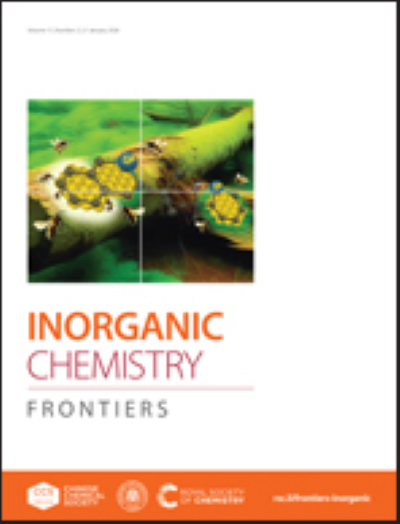fe -季铵盐功能化晶体聚三嗪亚胺半导体光催化CO2还原的机理研究
IF 6.1
1区 化学
Q1 CHEMISTRY, INORGANIC & NUCLEAR
引用次数: 0
摘要
从低成本、低毒性和激活小分子生产太阳能燃料的多功能性的角度来看,将地球上丰富的催化中心结合到光吸收结构中的策略是可取的。在此,我们证明了铁季吡啶分子催化剂可以锚定在一种吸收光的晶体氮化碳(PTI)上,从而产生一种分子-催化剂/材料杂化物,Fe-qpy-PTI,能够在低强度光照射下在水溶液中选择性地将CO2还原为CO(高达97-98%)。这种杂化材料利用了Fe-qpy催化剂在单电子还原上结合CO2的能力,就像从碳氮半导体转移受激电子一样。在50 mW·cm-2的低入射功率密度下,在0.1-3.8 wt%的催化剂负载范围内测量了杂化材料的催化活性,结果表明,在3.8 wt%的负载下,在3小时的实验中,CO的析出率高达596µmol·g-1·h-1。该杂化材料的CO析出率为608µmol·g-1·h-1,在TOF为~38的情况下,在8 h内循环305次。当功率密度达到150 mW·cm-2时,表观量子产率下降了约25%。施加在杂化材料上的较高光强度提供了活性的初始增加,但随着时间的推移对光催化速率产生了负面影响。瞬态吸收光谱结果显示电子存活概率与观察到的产物率一致。计算模型还用于评估和理解CO对H2的高产物选择性的机制途径。这些结果有助于揭示关键因素,利用分子催化剂在吸收光的半导体上减少二氧化碳的机理,并建立最佳条件,以在水溶液中获得最大的速率。本文章由计算机程序翻译,如有差异,请以英文原文为准。
Illuminating the Mechanistic Impacts of an Fe-Quaterpyridine Functionalized Crystalline Poly(triazine imide) Semiconductor for Photocatalytic CO2 Reduction
The strategy of incorporating earth-abundant catalytic centers into light-absorbing architectures is desirable from the viewpoint of low cost, low toxicity, and versatility at activating small molecules to produce solar-based fuels. Herein, we show that an Fe-quaterpyridine molecular catalyst can be anchored to a light-absorbing, crystalline, carbon nitride (PTI), to yield a molecular-catalyst/material hybrid, Fe-qpy-PTI, capable of facilitating CO2 reduction to CO selectively (up to ~97-98%) in aqueous solution under low-intensity light irradiation. This hybrid material leverages the ability of the Fe-qpy catalyst to bind CO2 upon a one-electron reduction, as achieved by transfer of excited electrons from the carbon-nitride semiconductor. The catalytic activity of the hybrid material was measured across a range of catalyst loadings (from 0.1-3.8 wt %) at a low incident power density of 50 mW·cm-2, resulting in rates of CO evolution up to 596 µmol·g-1·h-1 at a 3.8 wt% loading for a 3 h experiment. The hybrid material attained a CO evolution rate of 608 µmol·g-1·h-1, or 305 turnovers over the course of 8 h for a TOF of ~38. Apparent quantum yields reached up to ~2.4%, but which decreased by ~25% at a higher power density of 150 mW·cm-2. Higher light intensities imposed on the hybrid material provided an initial increase in activity but negatively impacted photocatalytic rates over time. Transient absorption spectroscopy results showed electron survival probabilities that were consistent with the observed product rates. Computational modeling was also used to evaluate and understand the mechanistic pathway of the high product selectivity for CO versus H2. These results have helped unveil key factors to leverage the mechanistic understanding of molecular catalysts for CO2 reduction on light absorbing semiconductors and to establish optimal conditions to attain maximal rates in aqueous solution.
求助全文
通过发布文献求助,成功后即可免费获取论文全文。
去求助
来源期刊

Inorganic Chemistry Frontiers
CHEMISTRY, INORGANIC & NUCLEAR-
CiteScore
10.40
自引率
7.10%
发文量
587
审稿时长
1.2 months
期刊介绍:
The international, high quality journal for interdisciplinary research between inorganic chemistry and related subjects
 求助内容:
求助内容: 应助结果提醒方式:
应助结果提醒方式:


